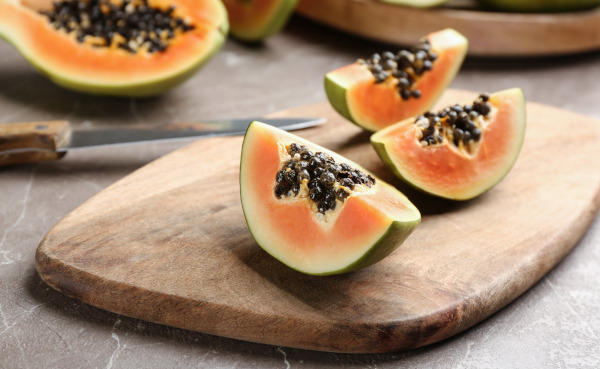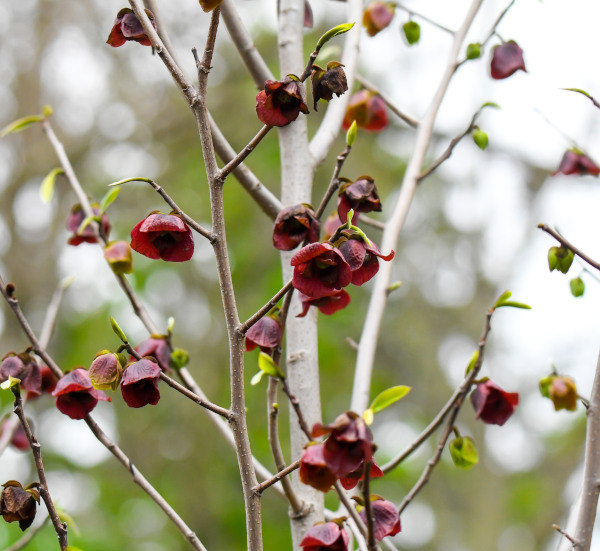How to grow Asimina
There are eight species in this genus, though only one, Asimina triloba, is widely cultivated. Also known as the pawpaw, this species is native to rich, moist soil in woodland clearings throughout eastern North America. With long, hot summers it can become a small tree, however in our UK climate it tends to remain a multi-stemmed shrub. It bears unusual, maroon, cup-shaped flowers on bare branches in late spring, which go on to develop large, mango-shaped fruit. In warmer climates these ripen to produce edible flesh, though they seldom reach this stage in the UK. The striking foliage turns shades of yellow in autumn.

Key Information
Soil pH
Position
Hardiness


Where to plant Asimina
For best results, plant in autumn or spring. An autumn planting can be done by those gardening in mild conditions (and broadly speaking, this is the southern half of the UK). For those liable to cold winters, it is best to wait until spring (generally the northern half of the UK). Planting can also be carried out in summer, though be prepared to water regularly.
Asimina makes a striking and curious addition to a shrub border or sunny woodland edge. It can also be grown in a large pot.
How to plant Asimina
- For planting in the garden, dig the soil area removing any large stones and weeds and breaking up any lumps. Mix in some organic matter such as manure or garden compost. Rake level and firm with your heels. Rake level again.
- Water plants well and allow to drain before planting.
- A good tip is to dig a hole twice the size of the root-ball. Fill with water and allow to drain before placing in the plant.
- Place the plant in the hole, ensuring the top of the root ball sits level with the surface of the soil. Too low and the plant may rot, too high and the roots can dry out.
- Backfill with soil and firm in gently with your foot.
- Soak well with water.
- Mulch around the base with well-rotted organic matter.
- For planting in containers, first choose an appropriately sized pot. The best practice is to start just a few centimetres larger than the rootball and increase in size every year or two. Ensure there are plenty of drainage holes in the bottom.
- If you are using a large or heavy pot, it can be a good idea to fill and plant it in situ to save yourself the trouble of moving once full.
- Use a good quality potting compost with some horticultural grit mixed in, and, if not already present in the compost (check the description on the bag) some slow-release fertiliser granules.
- Start by partially filling the pot with compost; enough so that when placed on it the upper surface of the root ball is about 3cm lower than the top of the pot.
- Infill all the space surrounding the root ball with compost, firming down with your fingers then adding a little more so the plant is held tight.
- Pick up the container and lightly tap on the potting bench or ground a few times to help further settle the compost around the plant.
- Soak well with water.
- A mulch with horticultural grit will look attractive and help to prevent a ‘cap’ or crust forming on the top of the compost (something container plants can suffer due to the artificial nature of their watering).

How to care for Asimina
Pruning and Deadheading
Asimina falls into RHS pruning group 1. This means it requires little pruning and is best left largely untouched.
The only pruning occasionally needed is a light tidy in late spring. Simply remove any dead, diseased, damaged, or badly placed branches (e.g., those rubbing against others, or growing towards the centre). Try to resist the urge to do any more than this as it is likely to spoil the natural shape of the shrub.
Watering
Like all trees and shrubs, asimina should be regularly watered during its first year or two in the ground, after which it should only need watering in hot dry spells – providing it is growing in reliably moist soil. When watering, give a deep, thorough soak then wait for the top few centimetres of soil to dry out before repeating (this encourages the formation of deep roots, as opposed to watering little and often which can result in roots growing mainly in the surface of the soil). To check this, wiggle your finger down into the soil until you hit a cool, damp bit. A mulch one or twice a year can be a big help in locking in moisture (see below).
Container-grown asimina has less access to moisture so will need regularly watering throughout every growing season. Again, water deeply and allow the top few centimetres of compost to dry out before repeating, though be aware that in the height of summer this can happen very quickly and some container-grown plants may need watering every day. From mid-autumn, the British climate tends to take over watering needs, though do remember to step in in the event of an unseasonably dry spell.
Feeding
Outdoors, in healthy, fertile soil, a spring application of general purpose granular feed lightly forked through the surface of the soil (known as a top dress), covered with a mulch of well-rotted organic matter (i.e., a layer of manure or garden compost) should provide adequate nutrients for your asimina. The mulch has the added benefit of suppressing weeds and locking in moisture. Do this again in early summer if your soil is on the poor, dry side.
Container-grown asimina relies solely on the gardener for nutrition and needs a little more attention. Get off to a flying start by making sure you use a good quality compost with some slow release fertiliser granules mixed in. After this, carry out a replenishing ‘top dress’ annually in spring. To do this, simply scrape away the top few centimetres of compost and replace with a fresh load with fertiliser granules mixed in. Remember also to repot your aronia every few years, going up slightly in size each time until it reaches full size. A balanced liquid feed can also be beneficial during the growing season – aim for monthly applications of this.
Cold Protection
- triloba has a hardiness rating of H5, meaning it should be fine in all but the most exposed spots. Protect with a handy fleece jacket if you have any concerns, e.g., if you garden in a frost pocket or on a site exposed to strong, cold winds.
It is worth noting that, while a moisture-loving plant, A. triloba resents waterlogged soil, particularly during winter. Inadequately drained soil can cause problems in the shape of root rot and reduced hardiness, making it important to choose your initial planting location wisely!
Any H5 plant in a container will benefit from having its roots wrapped in fleece, hessian, or bubblewrap in all but the mildest or most protected spots. This also reduces the chances of the container cracking during a frost.
Pests and Diseases
Asimina is considered problem-free.
How to propagate Asimina
We recommend layering as the best approach for propagating this shrub. Best done in autumn, this simple and effective technique involves pegging a wounded stem to the ground to develop roots while still attached to the parent plant. It requires far less input than most other methods of propagation, as the plant is largely left to do the work.
- Choose a few flexible outer shoots that can easily be bent down to the surface of the soil.
- Make a 5cm long incision where the stem will touch the ground, ensuring you slice through a leaf bud.
- Insert a matchstick to wedge the incision open slightly.
- Dig a small, shallow trench where the shoot will touch the ground (adding a little grit if the soil is heavy).
- Peg the shoot into the trench using thick wire or a strong forked twig.
- Fill with soil, firm in, and water.
- Mark the spot with a cane. Roots can take 12 months to form, making it easy to forget what you have done and where...!
- When a good root system has formed, sever from the parent plant and either replant elsewhere or put in a pot for growing on.
* Many plants carry Plant Breeders Rights and cannot be propagated for commercial purposes.
Common Asimina questions
- Is asiminia hard to grow?
Providing you can strike the balance between consistently moist yet not waterlogged soil, this shrub is straightforward and low maintenance. Give it plenty of nutrients to see it thrive (see our ‘Feeding’ section for more details).
It's also important to have realistic expectations – don’t expect to see much fruit in our climate, and be aware that what does form is unlikely to ripen. - Can asiminia be grown in pots?
It certainly can! Just make sure it is repotted every few years and kept fed and watered. - Will one asimina shrub grown alone produce fruit?
With the exception of a few of the newer cultivars which are said to be self-fertile, triloba requires at least two different plants planted near each other in order to produce fruit.




